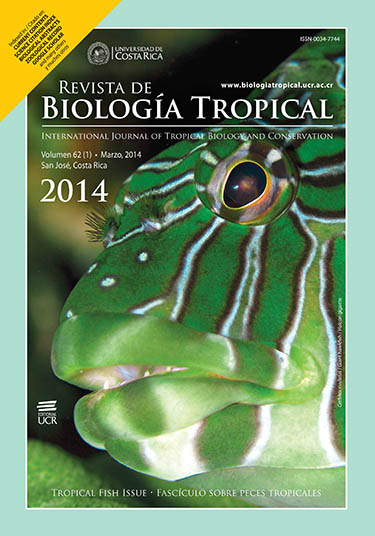Resumen
El caracol reina, Strombus gigas, es un gasterópodo de importancia comercial en el Caribe. Los estudios poblacionales se basan en el análisis de las fluctuaciones de las frecuencias de tallas, usando ya sea la longitud de la concha o el peso total de los organismos vivos. Este aporte usa datos de marcaje recaptura para estimar los parámetros de la ecuación de Von Bertalanffy y variaciones en el número de la población, para una población sin captura dentro de un área protegida, para aclarar que parámetros se adaptan mejor para estudios de la población entera o para las fracciones de juveniles y adultos por separado. Se muestrearon mensualmente, caracoles del parque Xel-Ha, de Noviembre 2001 a Agosto 2005. Todas las conchas encontradas se se midieron y marcaron con una etiqueta numerada que identificó la fecha de muestréo y la localidad. Las variaciones en abundancia mensual se estimó con el método de Jolly. Se emplearon la longitud de la concha, el grosor de labio y el peso vivo de los animales para determinar los parámeros de la ecuación de crecimiento de Von Bertalanffy, usando la subrutina de Appeldoorn del programa FISAT. La población varía a lo largo del estudio, con un mínimo de 49 organismos en abril 2003 y un máximo de 9 848 durante junio 2005. Los caracoles solo hacen uso temporal de la caleta de Xel-Ha. El mejor ajuste para juveniles se obtuvo con la longitud de la concha: L∞=251, K=0.3, C=0.8 Wp=0.3: mientras que para adultos se obtuvo con el grosor del labio: L∞=47.78, K=0.17, C=0.1, Wp=0.86; y la población total se ve mejor representada por el peso: L∞=3850, K=0.36, C=0.8, Wp=0.3. Se estimó una edad máxima para el total de la población de 19 años. Con mortalidad natural de 0.49 año-1 para juveniles y 0.29 año-1 para adultos. Hubieron dos pulsos de reclutamiento: otoño-invierno y verano. Se concluye que los estudios poblacionales realizados a partir de estructura de tallas, deben de analizar por separado dos grupos o fracciones de la población, usando el peso para juveniles y grosor del labio para adultos, de no ser posible analizar la población por separado, debe de emplearse el peso para evitar una subestimación en la estructura de edad.


